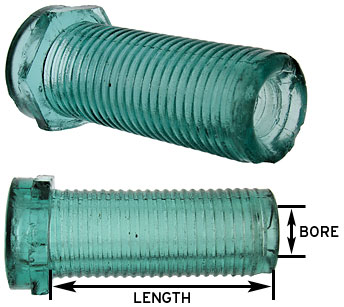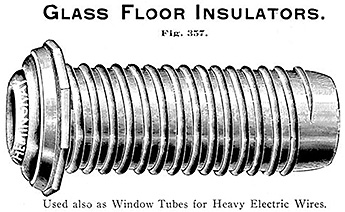
- Home
- Special Interests
Floor / Wall Tubes


Hemingray made several specialized insulators over the years, including glass floor tube insulators (also known as wall tube or window tube insulators). The purpose of these insulators was to carry a line through the floor, wall or window of a building, insulating it on all sides as it passes through. Floor tube insulators are not currently assigned CD numbers, though I would imagine they could in the future as we learn more about them.
Based on catalogs dating from 1893-1918, we know that Hemingray offered floor tubes in at least 14 distinct sizes, as listed in the table below. The corresponding style numbers range from No.120 to No.132. So far none of the floor tubes have been found embossed, despite catalog drawings showing them bearing the "Hemingray" name. (This was common with hand-drawn illustrations of Hemingray's insulators, and didn't always reflect the actual embossing).

There are three distinguishing characteristics of a Hemingray floor tube insulator: the length (minus the head), the bore (tapered hole inner diameter at the small end), and tube type (screw, without screw, or split plain). The diagram above shows how they are measured. Most of the floor tubes are of a screw type with a 6-sided (hex) head and outer threading; only No.124 and No.132 are not. The No.132 is also unique in that it is a two-piece insulator that is tongued and grooved.
Some floor/wall tubes have also been found with an 8-sided (oct) head, and in other measurements that do not correspond to any known Hemingray style number. It is unknown at this time if these are of Hemingray manufacture or not. Many of these are clear or SCA (sun-colored amethyst) two-tone due to sun exposure from an outside-facing wall, and some of these are reported to have come from the ghost town of Bodie, CA.
Hemingray-made floor tubes are known to come in several colors, including: aqua, light aqua, light green aqua, ice aqua, off clear, and lime green.
| Style # | Length | Bore | Type | Notes | Photo | Status |
|---|---|---|---|---|---|---|
| 120 | 2½" | ¾" | Screw | Last appears in 1915 catalog.1 | No Photo | ✓ |
| 121 | 3" | ½" | Screw | No Photo | ✓ | |
| n/a | 3" | ¾" | Screw | This size only appears in early catalogs dating from 1893, 1902 and 1904, apparently before they used style numbers. | No Photo | WANTED ($500 Reward) |
| 122 | 3" | 1" | Screw | I have found two variants of this style to date: the normal hex head and the earlier "stepped hex head", with 3 steps similar to No.124 below. | ✓ | |
| 123 | 3" | 1¼" | Screw | No Photo | ✓ | |
| n/a | 3" | 1½" | Screw | This size appears in one catalog, but I believe it may be a typographical error and should have been 1¼" (no other sizes have a 1½" bore.) | No Photo | WANTED ($500 Reward) |
| 124 | 3½" | ¾" | Without Screw | Last appears in 1915 catalog.1 | ✓ | |
| 125 | 3½" | 1" | Screw | No Photo | ✓ | |
| 126 | 4" | ¾" | Screw | ✓ | ||
| 127 | 4" | 1" | Screw | ✓ | ||
| 128 | 4½" | 1" | Screw | No Photo | WANTED ($500 Reward) | |
| 129 | 5" | 1" | Screw | ✓ | ||
| 130 | 6" | 1" | Screw | ✓ | ||
| 131 | 6" | 1¼" | Screw | |
✓ | |
| 132 | 6" | 1" | Split Plain | From 1918 catalog: "The 6-inch split insulators are in two pieces, tongued and grooved, and fit together closely."2 | ✓ |